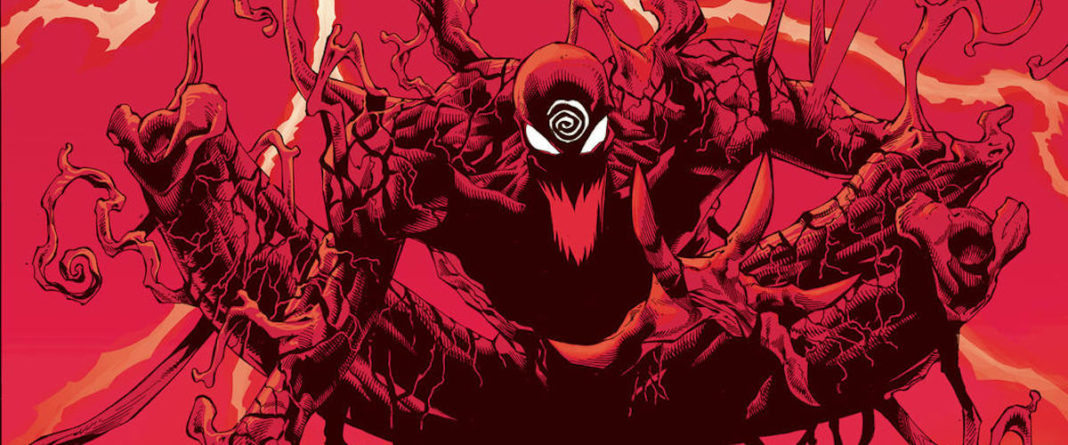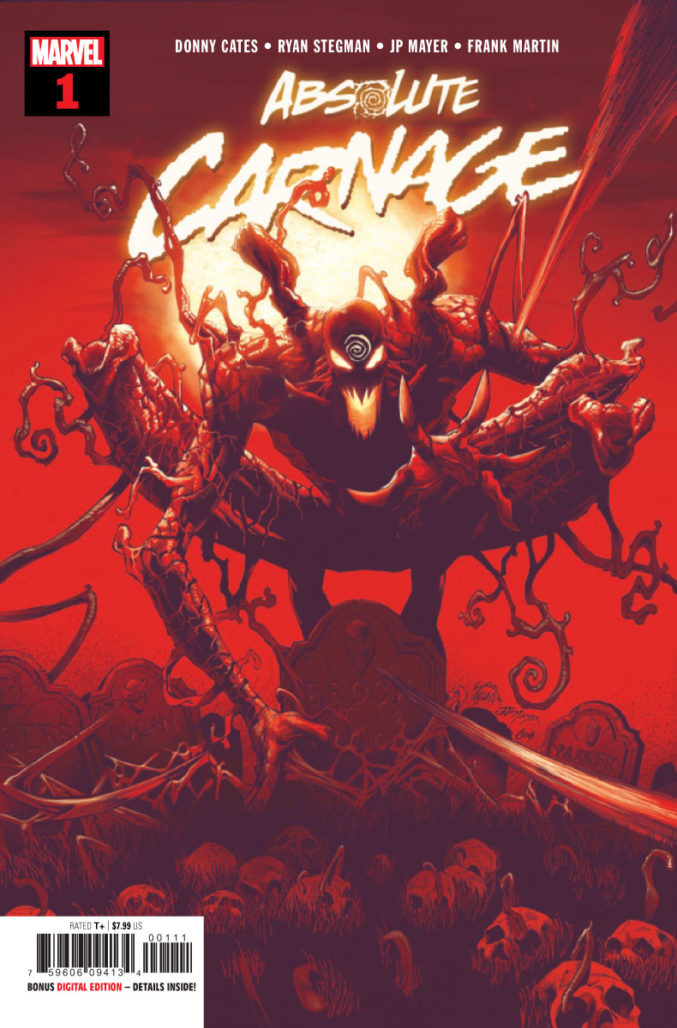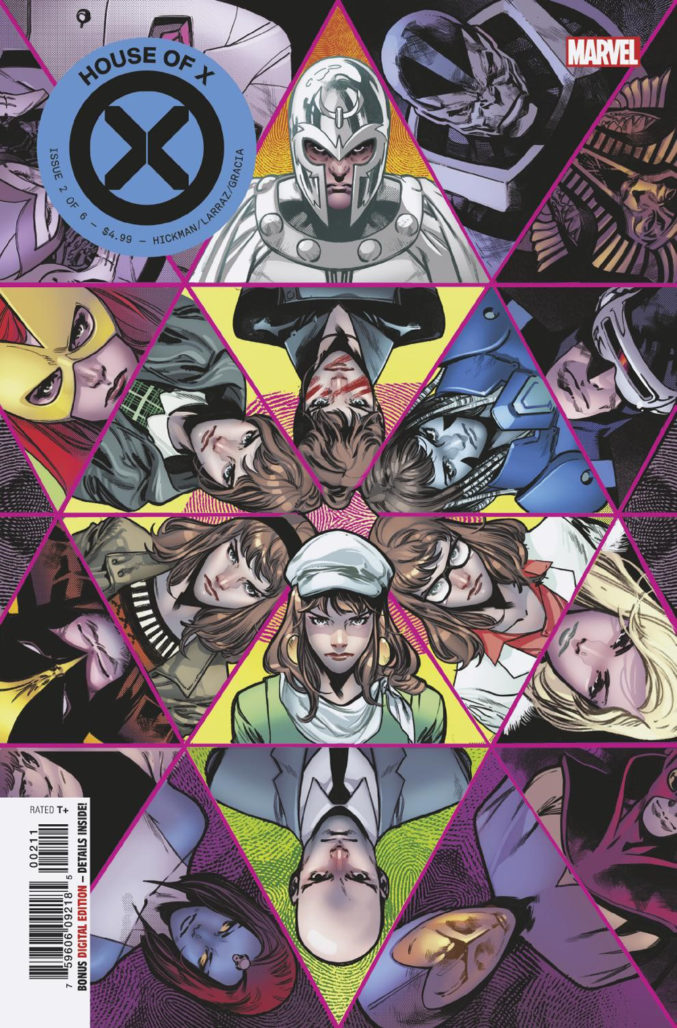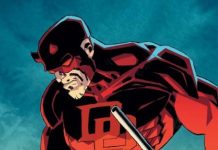This week’s Marvel Rundown tackles two absolutely massive Marvel entries this week. First up, the publisher’s latest event, Absolute Carnage, begins with an oversized first issue. Donny Cates‘ and Ryan Stegman‘s Venom run has been leading up to this, and we discuss whether the debut issue delivers on the build-up. Then, Jonathan Hickman‘s new era for the X-Men continues in the game-changing House of X #2. We examine Hickman’s and artist Pepe Larraz‘s sprawling, franchise-redefining tale. Don’t miss the latest, greatest installment of The Marvel Rundown!
NOTE: This week’s Rundown includes spoiler discussions for both Absolute Carnage #1 and House of X #2. Do not read any further if you haven’t read and wish to remain unspoiled for either of those titles.
 Absolute Carnage #1
Absolute Carnage #1
Written by Donny Cates
Pencilled by Ryan Stegman
Inked by JP Mayer
Colored by Frank Martin
Lettered by VC’s Clayton Cowles
Cover by Ryan Stegman, JP Mayer, & Frank Martin
Alexander Jones: Joe, the debut of Marvel’s latest event, Absolute Carnage is here! Marvel’s publishing format for this story is incredibly ambitious with a $7.99 price-point for a 72-page comic. Ongoing Venom writer Donny Cates and artist Ryan Stegman are back for the big event. I’d like to ask one core question of you: how much Venom is too much Venom?
Joe Grunenwald: Absolute Carnage #1 is certainly a lot of Venom, and basically reads like an overstuffed issue of the character’s solo title. Still, as the kickoff to an event storyline, I thought it worked well in establishing some big stakes for both Venom and the overall Marvel U. How did you find it?
Jones: I found this to be less inspired than some of the other works from Cates at Marvel. I really enjoyed some the zanier elements from the run and find the mythology aspects of the story interesting. The overstuffed nature you hinted at made this issue read like a marathon—I think I’ve had my fill of the property for a good while now.
Grunenwald: For as long as this issue is, I thought it read really briskly. The splitting up of the issue into chapters helped with that a lot. I also appreciated the relative lack of exposition, with a few pages at the beginning to bring new readers up to speed, and then Cates and Stegman get right into the story. That said, I can see what you’re saying about this story feeling a little uninspired. The actual plot is fairly straightforward, with each codex being a MacGuffin for Venom, Spidey, and Carnage to chase after. Where I think this issue excels is in the characterization of Eddie and of the Venom symbiote, and in the overall mood of the piece. One of the things I remember most vividly about the early Carnage stories was the sense of terror associated with the character, and I think that’s captured throughout this issue in both Cates’s writing and the artwork of Stegman, inker JP Mayer, and colorist Frank Martin.
Jones: I’m having a difficult time understanding the appeal of a heroic Eddie Brock. He sinks so low with some of his morals that it is hard to take him seriously as someone Spider-Man would contend with. While the book read quickly, I grew frustrated in seeing Eddie Brock as a leading man, typical action hero. I’m also really disappointed that Cates isn’t able to meld the creative mystical elements of Venom to get more mileage out of the story. Silver Surfer: Black embraces these same elements in a really creative way. It is almost difficult to reconcile this as the same writer.
Grunenwald: I did bristle somewhat at the opening text page’s summary of Eddie’s history saying that he and the symbiote “fought crime as Venom.” I know it’d be impossible to capture the nuance of a character’s thirty-plus-year history in a hundred-word paragraph, but that’s a vast oversimplification of the character’s arc. And I wouldn’t say that I was really into what was going on in Absolute Carnage #1 until Spider-Man showed up, which thankfully was pretty early. If this had been a straight Venom vs. Carnage story, I probably would’ve been pretty bored. To your point about Cates’s handling of the more far-out elements of the symbiote mythos that he’s established in Venom and elsewhere, I wonder if we won’t see more of that as this series progresses, either in the main title or any of the many spin-offs. This opening issue felt like a way to bring people in. Now that that’s out of the way, Cates is free to dive deep on other things.
Jones: For all the negative things I had to say about the issue, I wasn’t totally down on the book. The script has a certain level of plotting and general quality that guided me to the last page with ease. I was genuinely entertained during Spider-Man’s introduction. Some of the conflict between the two heroes in that scene felt a little contrived along with the rest of the issue. I also find Ryan Stegman’s art to be inconsistent. I have more kind things to say about his work during the busier, more imaginative sequences filled with mythology and detail. Some of the quality during the more mundane talking head scenes has a generic, dull look. I would argue that Stegman’s pencils here don’t fall in Marvel’s traditional house style and may not be better for it.
Grunenwald: Stegman and Mayer’s work definitely has a lot of flair during the more action-oriented sequences. The opening pages of exposition also did a great job of presenting a lot of information in a visually-interesting way. Scenes later in the issue of characters sitting around talking in a diner or a warehouse are less exciting, and I kind of wonder if the brief action sequence at the end of the diner scene was added by Stegman just so he would have something interesting to draw. The sequences in the subway and at the Ravencroft Institute, though, are rendered superbly. I can’t imagine the volume of ink that Mayer must have used on those sequences, and Martin’s colors compliment the heavy shadows of the linework well. Those scenes are the ones that the reader walks away remembering, and they more than make up for some slightly dull talking heads in the issue’s mid-section.
Jones: I think some of this has to do with Stegman’s layouts becoming less animated during the talking head sequences. The first few pages of the story are particularly breathtaking and ambitious from an art perspective. I also want to take a moment and single out the art team for modernizing the artistic legacy of the character. We still see characters that defy all semblance of anatomy but that isn’t a bad thing in some of the more detailed portions of the interiors. I wish Stegman took more chances to tell the story in an interesting manner and stay challenged through the full run-time of the book.
Grunenwald: I think the fluid anatomy works for the symbiote-infused characters. For me it definitely adds an element of menace to this latest incarnation of Carnage. Any final thoughts on this book, or are we ready to render our verdicts?
Jones: How much Venom is too much Venom?
Grunenwald: I think this event is out answer that very question.
Jones: I think this issue is a BROWSE. If you are interested in the character I don’t think this chapter will let you down. I really appreciated the comedic relief and hope Cates will get farther into Knull as the series continues.
Grunenwald: Coming so soon on the heels of the excellent War of the Realms event, Absolute Carnage #1 had its work cut out for it. There’s some really exciting visuals and solid storytelling throughout, even if the mid-section of the issue drops off a bit, and I’m interested to see how what appears to be Marvel’s first horror event plays out. At eight bucks for 60 pages of story, this book’s a big commitment both financially and time-wise, especially if you’re even a little bit on the fence about it. For that reason alone I’d give this issue a BROWSE.
Final Verdict: Absolute Carnage #1 earns a BROWSE verdict from The Marvel Rundown team!
 House of X #2
House of X #2
Written by Jonathan Hickman
Illustrated by Pepe Larraz
Colored by Marte Gracia
Lettered by VC’s Clayton Cowles
Design work by Tom Muller
Cover by Pepe Larraz & Marte Gracia
Alexander Jones: Joe, House of X #2 is here! The chapter recontextualizes the story up to this point and had me running back to previous issues for additional details I glazed over. I was really happy to see Jonathan Hickman, Pepe Larraz and Marte Gracia peel back the curtain and let readers in on a huge piece of the new X-Men mythology. I’m also curious to hear your take on the epic new installment of the series!
Joe Grunenwald: If by “the story” you mean 56 years of X-Men history, then yes, I would say this definitely re-contextualizes things. I was not at all prepared for the plot freight train that was this issue. For what is essentially 30 pages of exposition, I found it absolutely riveting. Just…wow.
Jones: As good as the script is, I think this issue is also a tremendous achievement for Pepe Larraz and Marte Gracia. Larraz’s visual interpretation of the script filled in some of the moments off-panel and drew me directly into the narrative. I love Larraz’s page layouts and framing on some of the panels in the issue. Larraz appears devoted to telling the story the most interesting way possible. His grounded approach to the pencils made it easy for me to connect the words to the dialogue and empathize with Moira’s journey throughout the issue.
Grunenwald: I completely agree with you on the strength of the issue’s visuals. Larraz’s page layouts as the issue progresses are a truly impressive piece of storytelling. Aside from one really critical scene fairly early on, most of the issue is told in straight narration, and as Moira cycles through her lives the page layouts evolve, from straightforward page-width horizontal panels, to panels that are slightly slanted but still more or less uniform, to fanned-out panels of imagery, fragments, and eventually images that are just plain sideways. It’s an incredible visual representation of Moira’s journey and her changing state of mind as her life goes forward.
Ending the issue with the uniform panels again, representing the scene from the beginning of Powers of X #1, is a beautiful way to tie everything together and show the reader how far Moira has come in her understanding of the world and her place in it. It’s honestly breathtaking.
Samantha Puc: Hey guys, can I join this House of X party?
Grunenwald: Sam! Pull up a chair! Was your mind as thoroughly blown by this issue as at least mine was?
Puc: Uh, yes. Anyone who claims they saw this coming is lying. This issue read almost like a prose novel, but the art is just next-level stunning. Every single panel communicated so much information but kept my eyes absolutely glued to the page. I frequently get frustrated by overly-wordy comics, but I did not have that experience at all with House of X #2!
Jones: I agree with the point you made about not seeing the issue coming. The comic book press teased that something big was coming with this issue, but I didn’t expect to have so much context be centered around one focal character. House of X #2 doesn’t give readers all the answers they are looking for as well, which I sincerely appreciated. Hickman unveils a ton of new plot details but we still don’t know significant portions of his vision for the franchise. I think the issue did an excellent job introducing an outside force and giving stakes to the dual mini-series kick-off. Also, welcome to the discussion Sam it’s great to have you!
Grunenwald: Yeah, despite the sheer volume of information presented in this issue, we still don’t really know how the status quo presented in House of X #1 was established, and I love that. And now we have the added question of how Moira fits into the establishment of said status quo.
Puc: Quite frankly, I’m so impressed with how seamlessly Hickman has retconned so many years of not just X-Men history, but Marvel history as a whole. Moira playing such an integral role across all of these timelines — including the current one — has a huge impact on so many stories that we haven’t even felt yet. Also, I just want to say: her mutant power may be the most badass of the lot.
Grunenwald: Moira’s ability is the best new power since Darwin’s. (Comic book Darwin, not movie Darwin.)
Jones: I agree with all of the above points. I should have seen something coming with Moira playing a central role in the teaser image and House of X debut but I still thought the character on the cover was Kitty Pryde until I opened up the issue. Shame on me. I also want to make the point that Hickman doesn’t appear to be lying in the marketing materials or the premise of the series, he just seemingly has a lot of information to share with readers that will come out over the course of both books.
Puc: My favorite thing about this retcon is that Hickman completely centers Moira and posits her as not just the driving force behind Charles’ vision, but as the character who created that vision. Across all of her timelines, she adapts, alters and changes her approach, but her vision for mutantkind remains mostly consistent. By timeline #10, the current one, she seems to truly just be Over It. And it’s kind of incredible to see Hickman take so much of who Charles is as a character and say to the audience, “Actually, Moira did this.” It’s bold, and it’s refreshing as hell, and I love it.
I also have a new pet theory behind who’s wearing the helmet, but I’m sure I’m not the only one there. And I agree that Hickman isn’t hiding anything — he’s just very carefully laying this groundwork. I don’t even mind Marvel being so hush-hush about this issue now that I’ve read it.
Grunenwald: Moira is a character that I’ve always been mildly fascinated by. She’s a human who’s an ally to Charles and mutantkind in general for no reason other than, why wouldn’t she be? So it’s a little sad to me to see that element of the character go away, but what we end up with in its place is equally as interesting, and placing her at essentially the center of the X-Men mythos is a bold, bold choice. I also love that this is all introduced in the most ‘X-Men’ way possible — Hickman’s first order of business is to add ten new alternate timelines to the X-Men canon. Bravo.
Jones: I really wonder if we are going to see the trend of other comics creators getting more ambitious at Marvel to follow suit with what Hickman is plotting. This is a pretty big retcon for Moira and I love that it makes her character so important. I can’t shake the feeling with how much this issue out of context reads like a chapter of The Twilight Zone. The impressive part of the issue is how seamlessly Hickman weaves this plot point back into continuity. I have seen him take similar approaches in his Big Two work like his incredible characterization of Doctor Doom that became the focal plot point of Secret Wars.
Puc: I do think it’s unfortunate to see Moira’s humanity retconned, but I am so pleased with the overall execution of this plot (so far) that I can’t mourn too much. The extra timelines make me curious about the trajectory of Powers of X: would the world look the same in any of these dimensions? It’s also interesting that Moira is reincarnated as the same person, on the same trajectory, every single time — it implies that everyone is living certain things over and over again, which is heavy indeed. I am not super familiar with Hickman’s past work, so this has been… impressive, to say the least.
Grunenwald: Are the future scenes shown in Powers of X #1 even from what we know as the main timeline? Or are they from one (or many) of the other alternate timelines created by Moira’s reincarnations? I have so, so many questions.
Jones: I think we are supposed to be asking questions like you mentioned Joe. Also, I wanted to circle back to the point about Moira losing her humanity. She has been lingering in the X-Men continuity for a number of years. Seeing Moira revealed as a mutant makes sense with just how resilient she has been as an X-Men supporting cast member over the years. Joe, Samantha, did you find Larraz’s art as integral to telling the story in the chapter as I did here?
Puc: Oh, absolutely. So much is gleaned from the art alone, especially as her life shifts through each reincarnation and timeline. Joe really dug into this right before I crashed the party (sorry!) but the art is just. Whew. I just re-read the issue and spent quite a bit of time studying it.
Grunenwald: As Sam mentioned, I talked earlier about the page layouts, but even beyond that, the artwork from everyone on the team is really impressive. Larraz is tasked with presenting the same scenes multiple times, and he does an excellent job varying the way things are presented so that it’s never boring. There’s one panel in particular that is presented three times throughout the issue, with the only different element being Moira in the foreground, and the way Larraz presents Moira in those panels is fascinating to look at on its own. Marte Gracia also does an incredible job with his coloring of tying all the disparate timelines together while still differentiating each of Moira’s lives from each other.
Jones: I also found myself enjoying the text pieces and design work from Tom Muller and Jonathan Hickman more than ever before. The graph at the end adds even more context to the issue, showing off the astonishing plotting and care behind this relaunch. I also really liked how the prose pages interacted with some of the story sequences and paid off such an important part of the narrative. I found the back-matter in the issue to be integral in understanding Moira’s journey and more important than previous installments.
Puc: The emphasis in the prose on Moira’s mind is really well-placed, especially against the backdrop of information presented in HoX #1 and PoX #1. I loved how clear-cut the timeline in the back of the issue is and how it shows us all of Moira’s lives and the points at which she made different decisions. The color coding there is also fascinating, with the current timeline in black… Also, Joe pointed out to me that her sixth life is missing. So what happened there?
Grunenwald: Her sixth life is missing, and we don’t yet know how her ninth life ended. Mysteries upon mysteries. Guys, I loved this comic.
Jones: I love this comic as well and think Hickman pulled off a risky continuity retcon extremely well. Does anyone have any closing words before we deliver a final verdict?
Puc: Just this: I haven’t had my heart pump that fast while reading a comic in quite some time, and the rush was incredible. OH, AND: I really appreciate that Hickman not only called out Xavier’s god complex, but obliterated it by centering Moira in the X-universe. Just. chef’s kiss
Grunenwald: So we’re all giving this one a skip, then?
Jones: Just you Joe. I’m giving House of X #2 a BUY verdict and think it is worthy of your time and marks the first big payoff for the newest X-Men relaunch.
Grunenwald: I’m clearly joking. This gets a BUY from me as well. Even if you haven’t read the preceding two issues of HoX and PoX, House of X #2 stands alone as a compelling and incredibly crafted comic.
Puc: We’re unanimous. This is a BUY from me, and I agree that this can stand alone.
Final Verdict: House of X #2 unites The Marvel Rundown with a BUY verdict!
Next week, Gwenpool strikes back!



 Absolute Carnage #1
Absolute Carnage #1
 House of X #2
House of X #2






I do like that her most recently life is 10-I mean, X. I am enjoying watching Hickman play with the X/10 ideas.
Comments are closed.